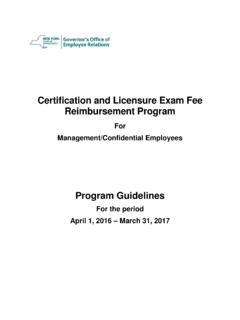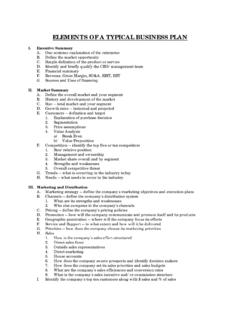Transcription of MERIT SYSTEM GUIDE for MANAGERS - OMCE …
1 MERIT SYSTEM GUIDEfor MANAGERSNew York State Department of Civil ServiceAlfred E. Smith State O ce BuildingAlbany, New York 12239 Updated November 20101 Introduction As an executive staff member or manager , you will undoubtedly have responsibility for the selection or pro-motion of agency staff. How do you know where to start and/or what options are available to you in relation to establishing your agency s workforce? First, it is important to note that New York State public sector em-ployment is built upon a MERIT SYSTEM which is based upon the State Constitution and a foundation of Civil Service Law, Rules and Regulations.
2 As will be discussed in greater detail, section 35 of the Civil Service Law divides State employment into the unclassified service and the classified service. For the most part, positions in State agencies are in the classified service of the State, and fall within one of the four jurisdictional classes into which the classified service is divided: the competitive, non-competitive, exempt and labor class. How MERIT and fitness is determined and how appointments are made varies depending upon the jurisdictional classification of a position.
3 It is important to note that where an employee serves at the pleasure of the ap-pointing authority, such as with exempt class or non-competitive confidential policy-influencing positions, other control agencies and/or rules and procedures come into play, including the Division of the Budget and/or the Governor s Appointments Office. As discussed later, the establishment of and/or appointment to such positions requires consultation with these entities and their approval. Further, agencies are reminded that the July 30, 2008 hiring freeze remains in effect; only essential hires will be a question and answer format, this document highlights various tools which can help you establish and maintain your workforce, consistent with proper MERIT SYSTEM principles.
4 Please keep in mind that this general GUIDE is not meant to be inclusive of all of the details and nuances of a SYSTEM that is quite complex. In addition to reviewing this GUIDE , it is strongly recommended that you meet with your agency human resources (HR) office to obtain a more comprehensive understanding of the various hiring tools that can be used in relation to the different jurisdictional classes. This is important to ensure that candidates for employment are thoroughly aware of their benefits and status.
5 Each agency may have unique processes and agreements with the public employee unions. It is critical to discuss these differences with the HR office in your agency. We hope that this document will serve as a useful general resource of information about the various hiring and selection options available to State agencies. What is the basis for the MERIT SYSTEM in New York State? Article V, section 6 of the State Constitution requires that appointments to the classified service of the State be made according to MERIT and fitness to be ascertained, as far as practicable, by examination which, as far as practicable, shall be This MERIT and fitness clause is the underlying principle for the appointment and promotion of employees in the classified service of the State.
6 The Civil Service Law, Rules and Regulations implement this constitutional mandate. Who administers the MERIT SYSTEM in New York State? The Department of Civil Service and the State Civil Service Commission exercise authority over the classified service of the State. While many people make no distinction between the Department and Commission, each maintains its own independent identity and functions. General authority and responsibility for the administra-tion of the Civil Service Law is vested in the Department. The Commission is vested with broad MERIT SYSTEM oversight responsibilities for both State and local government.
7 23Do State agency employees serve in the classified service of the State?Generally, yes. The civil service is divided into the unclassified and classified service. The unclassified service includes: elective offices; offices filled by election or appointment of the legislature on joint ballot; legislative officers and employees; department heads; certain officers and employees appointed by the Governor; officers, members and employees of boards of elections; the largest group, teachers and supervisory personnel in the public schools, the State University, and certain community colleges.
8 The remaining positions fall within the classified service and are divided into four distinct classes, namely: competitive class; non-competitive class; exempt class; labor class. Together, they comprise the four jurisdictional classes of the classified service. Who determines the jurisdictional classification of a position? By law, all positions in the classified service are automatically in the competitive class unless the State Civil Service Commission takes action to place them in the exempt, non-competitive, or labor class.
9 Agencies may petition the Commission to place existing positions, new positions, within the exempt, non-competitive, or labor class. Upon a Commission determination that competitive examination is not practicable, positions are classified as other than competitive and can then be filled outside of the competitive examination pro-cess. Keep in mind that the jurisdictional classification review process generally takes at least one month and requires justification by the HR office in your agency. Agencies requesting an expedited review should contact the Office of Commission Operations.
10 Is the appointment process the same for each of the jurisdictional classes?No. The Constitution requires appointments be made by competitive examination, to the extent practicable. In recognition that competitive examination may not always be practicable, the Legislature carved out a number of exceptions and created the four distinct jurisdictional classes, each having a separate yet equally valid test of MERIT and fitness. How MERIT and fitness is measured and how appointments are made, will depend upon the jurisdictional classification of the position.









